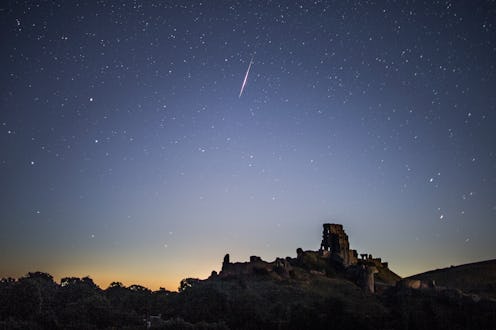Life
How To Find The April Fools' Day Comet

This Saturday, take a break from your regularly scheduled pranking to remember that humanity is but a dust mote floating in the sunlight of the universe — or however it is skywatching makes you feel. The point is that this year, you can catch an April Fools' Day comet passing right by Earth on its journey around the solar system. So in between painting your roommate's soap with clear nail polish and texting your mom that you're pregnant, find some time to check out the night sky; I promise I'm not pulling your leg.
The event in question is the Tuttle-Giacobini- Kresák comet, also known by the even less appealing name of 41P. Discovered in 1858 by Harvard astronomer Horace Parnell Tuttle, it was rediscovered in 1907 by Michel Giacobini and again in 1951 by Lubor Kresák. It wasn't until this last discovery that astronomers realized Kresák, Giacobini, and Tuttle had all discovered the same comet. I get the feeling that if 41P was a human, it would have been picked last for gym class.
According to EarthSky.com, it's a periodic comet with an orbit that takes about 5.5 years to complete. 41P is typically very faint, but it's famous for its tendency to flare up into sudden brightness. In fact, in 1973, it brightened so quickly that some astronomers thought they'd discovered a new comet (again) — until it turned out to be good old 41P, orbiting as scheduled.
Astronomers have calculated that this year is the closest 41P will approach Earth since its first discovery in 1858. According to Space.com, its orbit will take the comet right by our planet over the course of six days, from March 29 to April 3. The closest point will come on April 1, when it will zoom by at a distance of just 13.2 million miles from Earth. That might sound far away, but as EarthSky.com points out, it's only about 50 times the distance of the moon. For a comet, that's fairly unusual, but not unheard of.
By the way, the nearness of 41P may be rare, but it's still totally safe. In fact, the comet that passed by on New Year's Eve a few months ago was even closer, so save your doomsday predictions for another day.
If you're interested in catching 41P this Saturday, Space.com suggests using a small telescope. It might be visible to the naked eye when it's closest to Earth, but it'll definitely be easier to spot with assistance. Look for the comet in the northern part of the evening sky. Between now and mid-April, 41P will travel in front of the stars making up Ursa Major and Draco, so use the constellations as your guide. People living in the northern hemisphere should have no trouble finding the appropriate stars, but if you're located below the equator, you might want to sit this one out.
Don't get your hopes up for a spectacular show; as mentioned above, the comet tends to be faint. Then again, it does have a history of surprising skywatchers with flare-ups — wouldn't that be appropriate for April Fools' Day?